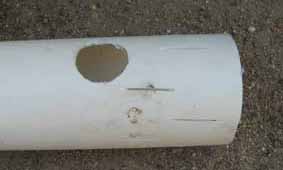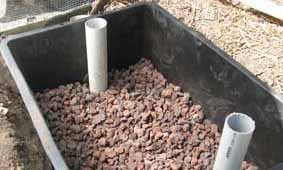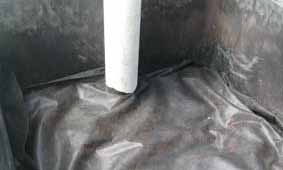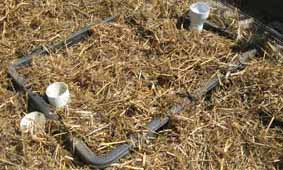vegetable
patch design
Wicking Beds
plastic tub wicking bed design and
construction - page 2.

5. Cut and drill outlet pipes.
Note that you do not need to have an outside protection/observation pipe if your wicking tub is going to be on top of the ground. Just cut one length of pipe for the inside if that is the case.
I used a grinder to cut the slots. You could drill holes instead of slots, but make sure the holes are fairly small. I suggest no more than 5 mm wide..
I used 90 mm PVC pipe for the one going on the outside of the tub and 65 mm PVC pipe for the one on the inside. I went for the 90 mm pipe on the outside so I could insert my hand to unblock the outlet pipe should if ever get blocked.
A number of different sized pipes could be used, just as long as you can insert the 20 mm threaded pipe into it.
6. install outlet
protection/observation pipes

6. Install outlet pipes
The outlet observation/protection pipes are there to prevent soil and stones from blocking the threaded tank outlet and allow any excess water to seep away.
7. cut and build the inlet
pipe.

7. Cut and build inlet pipe
Cut slots or drill holes in the pipe that is to lie on the bottom of the tub. Alternatively you can use a length of 50 mm agricultural drainage pipe, which already has holes in it.
Put a PVC cap at one end of the bottom pipe and connect it to the vertical pipe with a PVC elbow. Put a 50/90 mm adapter on top of the vertical pipe. This is where you add water to your wicking tub reservoir.
There is no need to use PVC glue to connect the pipes and fittings as they do not need to be waterproof.
8. Fill with stones

8. Fill with stones

9. Cover stones with weed mat

10. Fill with soil
I used 25 mm scoria stones but on later wicking beds I also used 20 mm bluestone stones. Both are fine, though the scoria is lighter and easier to shovel. It is also slightly cheaper.
9. Cover stones with weed
mat
Cover the stones with non woven weed mat. Cut a hole in the
mat to push it over the upright pipes. Make sure the mat fits snugly
around the pipe and edges of the tub because the weed mat is meant to
prevent the soil from mixing with the stones. As weed mat is
cheap I suggest you put two layers of weed mat down for extra protection
and longer life.10. fill with soil
Fill to the top with a light friable soil. If your
soil is very heavy then mix sand and organic matter with it to make
it more friable.If you have buried your tub in the ground as I did then fill in the hole around the tub and the outside PVC pipe.
concluding comments
While this design worked quite effectively as a wicking bed
there were three design flaws.A. The 50/90 adapter was added as an after thought as I found the 50 mm inlet pipe was too narrow for my to easily add water with my Dramm watering wand. Had I used 65 mm pipe for the inlet I would not have needed to use the adapter as 65 mm would have been large enough for the wand.
B. The main problem with this design was that I should not have placed the inlet and outlet pipes at opposite ends of the tub. You need to be able to see the overflow pipe as you are adding water to the inlet pipe so you know when the wicking bed reservoir is starting to overflow. Wicking beds that I built after this plastic tub bed all had the inlet and outlet pipes almost side by side.
C. Having a horizontal pipe channel under the bed of stones in such a small wicking bed is probably a bit of overkill and could be dispensed with. Later wicking barrel tubs that I made did not have this horizontal pipe, though admittedly they were a bit smaller in size than the plastic tub used for this bed.

